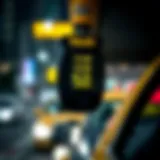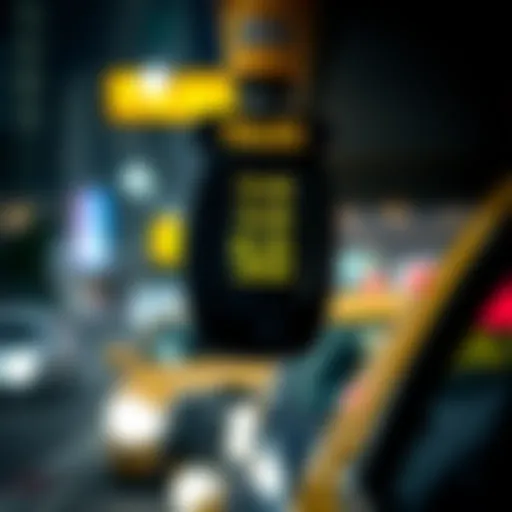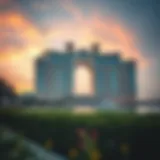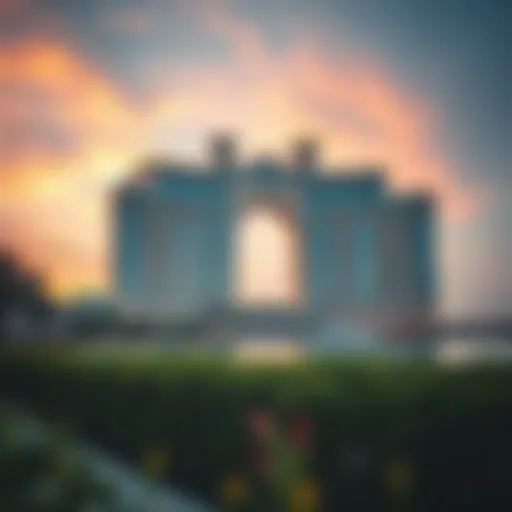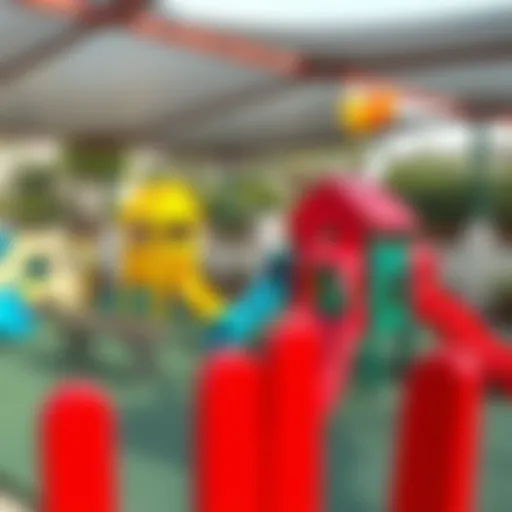Exploring the Dubai Metro and Tram Map: Key Insights
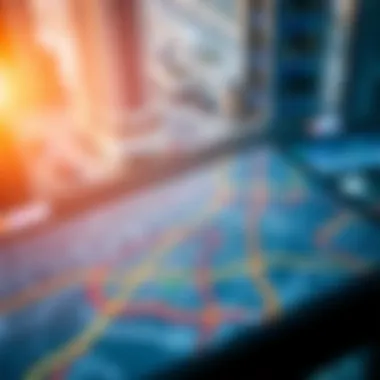

Intro
Dubai's urban landscape is characterized by its rapid growth and development, making efficient transportation systems a cornerstone of its infrastructure. The Dubai Metro and Tram network represents a significant leap in public transport innovation, catering not just to the city’s residents but to a myriad of tourists flocking to the emirate each year. Understanding this intricate system is paramount for investors, homebuyers, and those engaging with the city’s dynamic real estate market.
The integration of these rapid transit systems into Dubai's overall urban plan is no small feat, and as we dive into the logistics of the Metro and Tram map, we will uncover insights that are as practical as they are enlightening. We'll explore routes and stations, operational efficiency, and the broader implications for urban life.
As we embark on this exploration, it’s vital to appreciate how the Metro and Tram serve not only as a means of transport but also as catalysts for urban development. From neighborhoods undergoing revitalization to areas seeing a surge in property values, the influence of this public transport system is far-reaching and distinct.
Understanding Dubai's Public Transportation Framework
Dubai’s public transportation framework serves as the backbone of its connectivity and urban mobility. It plays a crucial role in facilitating the movement of millions of residents and visitors alike, making it essential to grasp its structure and significance. A well-established transportation system not only enhances daily commutes but also bolsters economic activity, alleviates traffic congestion, and minimizes environmental impacts. Moreover, understanding this framework is imperative for real estate investors and homebuyers who are keen on evaluating the locations with high accessibility. Public transport availability often influences property prices and desirability, which makes it a vital consideration for buyers.
A Brief History of Public Transit in Dubai
Dubai's journey in public transit began modestly in 1966, when the first bus services were launched, catering mainly to the local populace. At that point, transportation options were limited, and the city's sprawling development did not yet exist. Fast forward a couple of decades, the discovery of oil ignited rapid urbanization, leading to increased demand for a reliable transit system.
In 2009, the Dubai Metro system made its grand entrance with a mission to simplify commuting while dramatically reducing road traffic. The Metro has consistently expanded since its inception, introducing new lines and stations that connect vital areas across the city. Furthermore, the addition of tram services in 2014 further complements the Metro, creating a more integrated transportation experience.
Importance of an Efficient Transport System
An efficient transport system is paramount in an urban landscape like Dubai. Here’s why:
- Economic Growth: A well-functioning transit network attracts international businesses and elevates local commerce by facilitating smooth movement of goods and people.
- Quality of Life: For residents, an efficient public transit system reduces travel times, alleviates dependence on personal vehicles, and promotes healthier commuting options.
- Sustainability: By encouraging public transportation, Dubai aims to lower its carbon footprints and develop a greener urban environment. An extensive rail system minimizes reliance on fossil fuels compared to traditional automobiles.
- Tourism: A comprehensive transport network serves as a significant draw for tourists, providing easy access to attractions, shopping havens, and cultural landmarks.
In summary, the public transportation framework in Dubai is more than mere infrastructure; it's a catalyst for economic prosperity, social well-being, and environmental consciousness, revealing its intrinsic value in the city's development agenda.
Overview of the Dubai Metro System
The Dubai Metro stands as a crown jewel in the city’s extensive public transport framework. Understanding this system is pivotal for anyone navigating the bustling streets of Dubai, whether they’re tourists trying to catch the sights or residents commuting daily. Effective transit not only helps alleviate the persistent traffic congestion but also contributes significantly to the urban charm and economic viability of the area.
The Metro network connects diverse neighborhoods, offering accessibility to key destinations like shopping centers, business districts, and cultural sites enhancing the city's livability. You won't just find it crystal clear to travel; the Metro serves as a backdrop for city life, reflecting Dubai’s commitment to innovation and sustainability.
Key Features and Benefits
While gliding smoothly on the Metro, riders experience several notable features that set this transit system apart:
- Modern and Efficient Design: The trains are not only designed for comfort but also prioritize speed and efficiency, ensuring that commuters reach their destinations promptly.
- Electronic Ticketing: The NOL card system brings in a seamless ticketing experience. One card for all modes – Metro, tram, and buses, encouraging ease of travel without the hassle of cash.
- Accessibility Features: Stations are equipped with ramps and elevators, making it a user-friendly option for all demographics, including those with mobility challenges.
These features make the Dubai Metro a popular choice, easing the journey while emphasizing safety and efficiency. The benefits extend beyond mere transport; they stimulate economic activities and provide sustenance to the real estate market nearby.
Line Configurations and Stations
Dubai's Metro lines are meticulously planned, ensuring that maximum accessibility is achieved. The network currently includes the Red Line and the Green Line, each catering to specific areas of the city.
Red Line Overview
The Red Line is the backbone of the Dubai Metro system, extending over 52 kilometers. This line connects key areas, including the airport, to various business and leisure hubs.
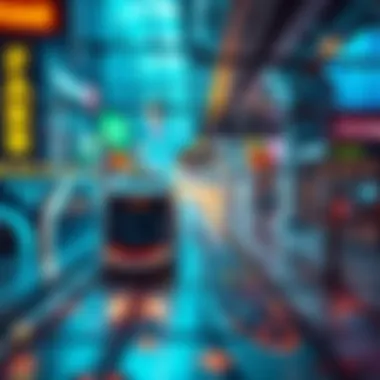
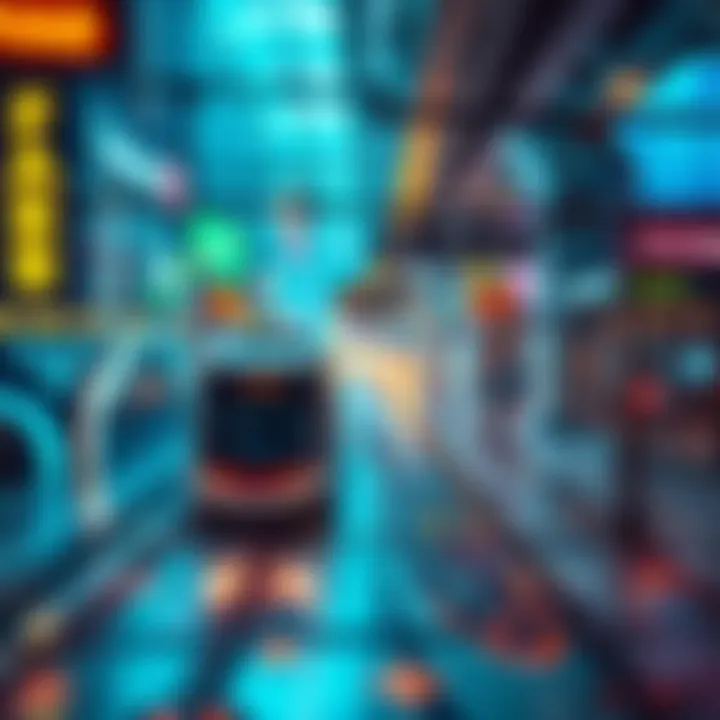
One of its standout features is its ability to facilitate movement between the bustling Dubai Mall and the nearby Burj Khalifa, making it a popular route for both residents and tourists. The Red Line operates at high frequency and forms a vital link for those traveling to central locations.
Green Line Overview
In contrast, the Green Line spans approximately 22.5 kilometers and complements the Red Line by covering a different section of Dubai, including areas rich in culture and community. Its importance lies in connecting the older parts of the city, like Deira and Bur Dubai, where you can find local markets and traditional experiences. This line's unique characteristic is its potential to foster tourism in historical neighborhoods, while also serving as a commuting route for many residents.
Future Line Proposals
As Dubai continues to grow, proposals for new metro lines aim to address future urban challenges. Planned expansions will focus on connecting emerging areas like Dubai South and major developments in the emirate, further enhancing network reach. A critical aspect of these proposals is integrating green technologies, which could reduce environmental impact and provide a cleaner city landscape.
This commitment to improvement and expansion demonstrates Dubai's dedication to not just maintaining, but actively evolving its public transit landscape to meet the demands of its dynamic population.
Navigating the Tram Network
Navigating the Tram Network in Dubai is not just about getting from point A to point B. It’s an experience that enhances how one interacts with the city. The tram system, while often overshadowed by the Metro, plays a vital role in the public transport ecosystem of Dubai. Here, we’ll explore the remarkable features of the tram system and how it seamlessly integrates with the Metro stations, thereby enriching the overall transit experience for residents and visitors alike.
Tram System Features
The Tram Network is a relatively new yet pivotal addition to Dubai’s transportation landscape. It covers about 14.5 kilometers of ground with 11 stops, primarily running through the bustling districts of Dubai Marina and Jumeirah Beach Residence. Some of the standout features of the tram system include:
- Modern Design: The trams boast sleek, contemporary designs and utilize the latest technology to ensure a smooth ride. The climate-controlled interiors offer comfort that caters to the region's warm climate.
- Safety Protocols: Enhanced safety measures, such as surveillance cameras and emergency protocols, are a hallmark of the tram system. This ensures that passengers can ride with peace of mind.
- Accessibility Features: The tram stations are equipped with facilities that cater to individuals with disabilities. Elevators, tactile guidance paths, and auditory announcements are just a few elements that help make the system accessible for everyone.
- Real-Time Information: Digital displays at stops and on trams provide live updates about tram arrivals and general service information. This transparency encourages punctuality and aids in planning trips more efficiently.
These features add layers of functionality and comfort to the tram experience, making it an attractive option for those looking to traverse certain parts of the city without the hassle of traffic.
Integration with Metro Stations
Another key aspect of the tram system is its integration with Dubai's Metro network. The interconnectivity of these two systems provides various transportation benefits:
- Smooth Transfers: Several tram stations are strategically located near Metro stations, allowing passengers to easily transition between the two systems without needing to plan extensive detours.
- Comprehensive Coverage: While the Metro might cover larger distances, the tram’s dedicated routes fill the gaps in areas where the Metro doesn’t reach. This means residents in the Marina can access key public spaces and recreational areas without hassle.
- Unified Ticketing System: Utilizing a unified ticketing system, commuters can travel across both networks with the same Nol card. This simplicity reduces confusion and enhances user experience while onboard.
- Expansion Possibilities: Future plans for extending tram lines and enhancing connections with new Metro expansions show a commitment to a more connected and efficient urban transit framework.
"An interconnected city is a thriving city - the tram and Metro working together is a fine example of how transit can enhance livability."
Details of the Metro and Tram Routes
The Dubai Metro and Tram routes are essential arteries of the city’s transportation framework. As urban growth escalates, so does the need for efficient movement within its bounds. The metro and tram systems not only redefine how residents and tourists traverse Dubai but also influence the real estate landscape, enhancing property values near key transport hubs. By understanding the intricacies of these routes, we begin to appreciate their role in shaping daily commutes, recreational activities, and overall urban planning.
Key Destinations Along Metro Lines
One cannot underestimate the significance of the metro lines when it comes to convenient access to Dubai’s prime locations. Some notable stations include:
- Burj Khalifa/Dubai Mall Station: Placed directly adjacent to the iconic Burj Khalifa and the expansive Dubai Mall, this station serves as a focal point for both tourists and local shoppers. It ensures a smooth transit for those wanting to experience the pinnacle of luxury and commercial offerings.
- Deira City Centre Station: Close to one of the oldest shopping hubs in Dubai, this station bridges the historic charm of Deira with modernity. It attracts countless shoppers and business travelers alike.
- Jafiliya Station: Ideal for those looking to explore the DubaiWorld TradeCenter and the bustling exhibition halls. This stop becomes vital during large-scale events, providing easy access to international visitors.
The metro’s reach doesn’t just touch on shopping malls. Parks, museums, and cultural centers are within easy access too. For instance, the Al Jafiliya Station connects commuters to the Dubai Garden Glow, enhancing the appeal of nighttime outings.
"Public transport is not merely about getting from point A to point B; it encapsulates the very essence of urban connectivity."
Popular Stops on the Tram Route
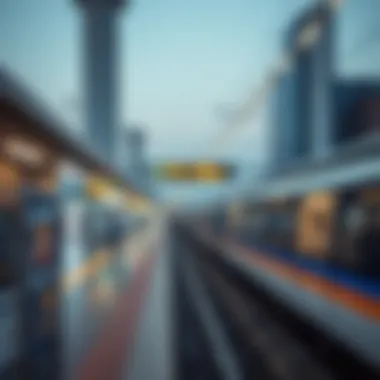
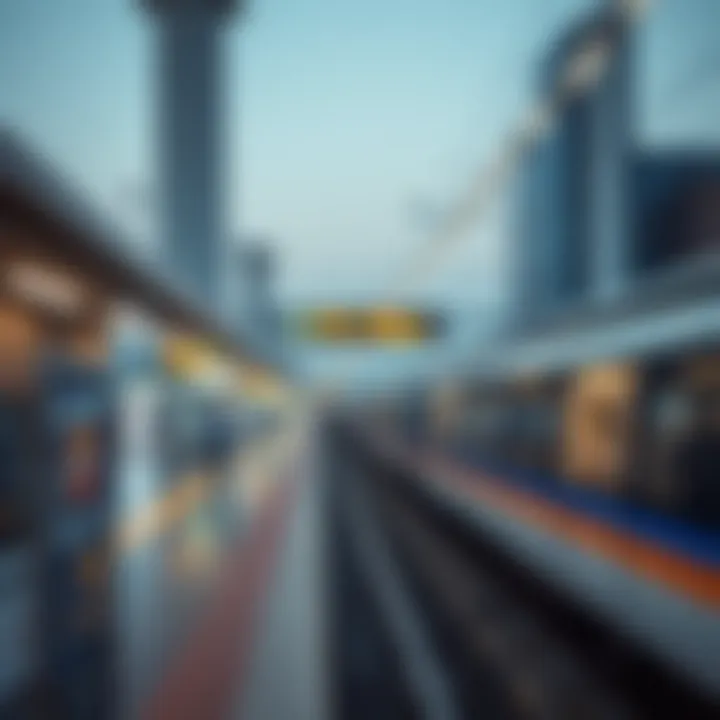
The Dubai Tram’s route complements the metro by connecting key waterfront destinations. Among its popular stops, consider the following:
- Dubai Marina Station: This station is a gateway to Dubai Marina, known for its vibrant atmosphere, waterfront dining, and luxurious lifestyle options. It’s a hive of activity, attracting locals and tourists who are keen to indulge in recreational pursuits.
- Jumeirah Beach Residence Station: Situated close to the picturesque beach, this station caters well to beachgoers and revelers who appreciate the sun-soaked leisure of JBR. The tram makes beach access effortless, allowing visitors to enjoy seaside activities without the stress of parking.
- Palm Jumeirah Station: This station represents a unique access point to one of Dubai’s most iconic developments. It facilitates visitors who wish to explore the Palm's luxury resorts and amenities.
Both the metro and tram routes create a symbiotic relationship that enhances urban mobility. With real estate investments often linked to proximity to these transit lines, the choices made by commuters, tourists, and business travelers ultimately reflect broader implications for the market.
Operational Hours and Ticketing
Understanding the operational hours and ticketing structure of the Dubai Metro and Tram system is pivotal for anyone navigating the urban landscape. This information not only helps residents and tourists plan their journeys, but also has a significant impact on the overall appeal of properties near transit stations. The meticulous scheduling and flexible ticketing options are designed to cater to the diverse needs of people in this fast-paced environment.
Metro Service Times
The Dubai Metro operates at planned intervals, ensuring that commuters have reliable access throughout the day. On weekdays, services typically run from 5 AM until midnight, with extended hours on Thursdays, Fridays, and public holidays. This extended service accommodates late-night crowds and weekend leisure seekers.
Typically, trains arrive every 2 to 5 minutes during peak hours, which makes it easy for people to hop on without a long wait. Such efficiency is important for maintaining a smooth flow of travelers, especially during busy mornings or evenings.
- Remember: During the Holy Month of Ramadan, the schedule may change. It’s wise to check updates through the official RTA website or apps before planning your journey.
Tram Schedule Overview
The Tram system complements the Metro by offering a reliable option for short-distance travels within key districts. Trams run from 6 AM to 1 AM on weekdays, with slightly extended hours during weekends, making it convenient for both business and leisure travel.
Trams arrive at intervals of 8 to 10 minutes but are usually more frequent during rush hours. A noteworthy aspect is that the Tram system works hand-in-hand with the Metro. Many riders use the Tram to connect to various Metro stations, enhancing the seamless commuting experience in the city.
Ticketing Options and Pricing Structure
Navigating fare structures can sometimes be a bit tricky, but Dubai’s ticketing options are made simple for everyone.
- NOL Card: This is the most commonly used form of payment for both Metro and Tram services. It functions similarly to a prepaid card, which you load with credit and tap when boarding.
- Types of NOL Cards: There are various types of NOL Cards based on the needs:
- Red NOL Card: Ideal for tourists, it can be purchased for a one-time trip or a series of rides.
- Silver NOL Card: Better for frequent riders, this card allows more flexibility and offers discounted fares.
- Gold NOL Card: A luxury option that delivers extra benefits, allowing premium seating areas on the Metro.
A single journey ticket can set you back by approximately AED 3 to AED 7 depending on the distance traveled, which is a pretty reasonable rate given the level of service involved. It’s significant to note that boarding trams and metro during peak hours may incur a higher cost, reflecting the demand during those times.
“The pricing structure is strategically designed not only to provide value to commuters but also to promote the use of public transportation as a viable option compared to the rising costs of personal vehicle use and parking.”
In summary, knowledge of operational hours and ticketing options is vital not only for logistical planning but also impacts how residents and visitors perceive property values and transportation equity in this dynamic cosmopolitan city.
Impact on Real Estate Market
The influence of the Dubai Metro and Tram on the real estate market is profound and multifaceted. As cities expand and develop, access to efficient public transit options often becomes a key determining factor in property values and investment prospects. In Dubai, the introduction of the Metro system, coupled with the tram services, has reshaped urban living, making areas that were once considered remote or less desirable, now bustling hubs for activity.
Location Value Linked to Transit Access
One of the most significant aspects of urban development is the direct correlation between real estate prices and proximity to transit stations. In Dubai, being near a Metro or tram station can drastically enhance the attractiveness of a location. Properties located within walking distance to these transit points typically command higher prices. This trend can be attributed to several factors:
- Convenience: Residents prioritize ease of commuting. Areas close to the Metro or tram have become hotspots due to the promise of quick access to key areas of the city, whether for work, leisure, or education.
- Desirability: Conveniently located properties often attract a more affluent demographic, which enhances the overall economic status of the neighborhood. New developments are popping up around these transit hubs, often featuring modern amenities that appeal to buyers.
- Investment Opportunities: Investors are keen to analyze emerging trends. Areas near transit lines show robust rental potential, making them popular investments for those looking to capitalize on the growing demand for urban living spaces.
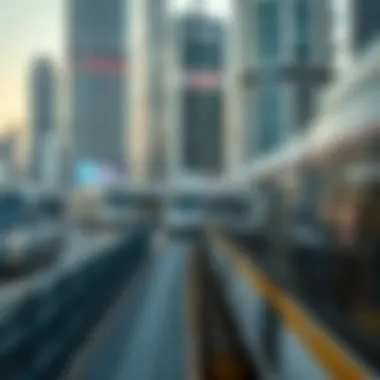
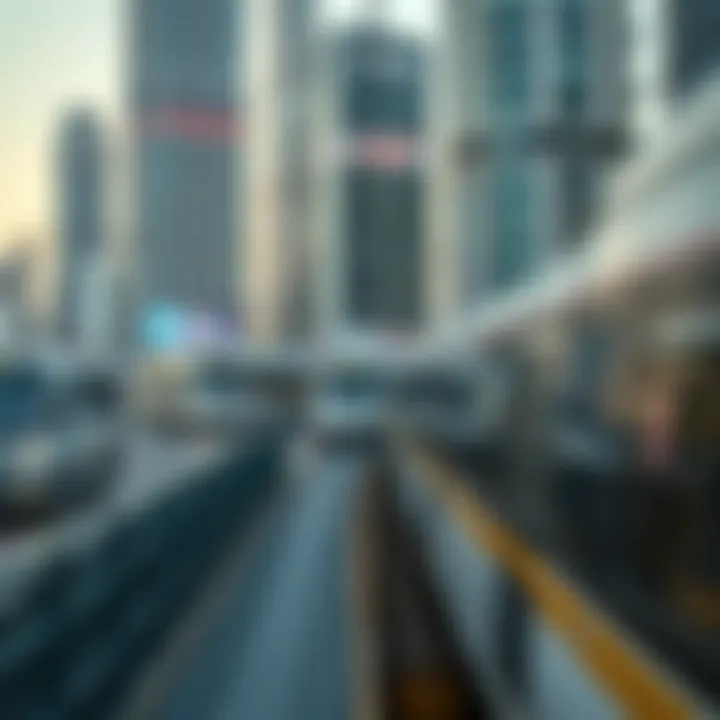
Investing in locations connected by the Metro and tram not only fulfills immediate housing needs but also offers substantial returns in the long run. As transit lines extend and evolve, so too will the dynamics of property valuations. The strategic placement of residential and commercial properties in relation to these transit systems will continue shaping Dubai's urban landscape.
Investing in Proximity to Transit Lines
With the rapid expansion of the Metro and tram networks, savvy investors are taking note. The proximity to transit lines is becoming a key criterion for property investment decisions. Here’s why:
- Urban Living Trend: The preference for urban living is on the rise, particularly among younger populations and professionals who are looking for accessibility without the hassles of long commutes. The Metro caters to this growing demand, making these areas more attractive to potential residents.
- Future Growth: As new lines and extensions are announced, properties that are currently a bit off the main lines still hold significant potential. Anticipating future growth can lead to substantial profits, as areas once seen as distant or less desirable become more connected and accessible.
- Government Initiatives: The Dubai government’s commitment to public transport reinforces investor confidence. With ongoing investment into infrastructure, it’s clear that the focus will remain on enhancing transport systems, which in turn supports further real estate development in the vicinity.
In sum, incorporating transit access into real estate considerations isn’t just smart; it’s essential in today’s swiftly changing urban environment. Investors, homebuyers, and agents alike need to recognize these trends and factor them into their strategic planning, making the most of the dynamic synergy between real estate and public transit in Dubai.
Challenges and Future Developments
As cities grow at astonishing rates, the public transport systems need to evolve, too. In the case of Dubai, its Metro and Tram systems have impressed many with their modernity and reach. However, along with those glowing reviews come challenges that must be addressed for the system to reach its full potential. Understanding these difficulties is crucial for investors, homebuyers, and urban planners alike, as they shape the future landscape of this vibrant city.
Current Limitations in the Transit System
Despite the advanced infrastructure, the Dubai Metro and Tram systems face several challenges that limit their efficiency and effectiveness. One of the primary drawbacks lies in the current network coverage. While the Metro does connect many key areas, there are still gaps that leave some neighborhoods underserved. For instance, areas like Dubai International Airport are only marginally connected to the Metro network, causing inconvenience for travelers.
- Urban Sprawl: As Dubai expands, the areas of interest are also quite distributed. Many residents find themselves outside the direct reach of Metro stations, necessitating a reliance on private vehicles or ride-sharing services.
- Overcrowding: Peak hours can witness overcrowding on trains, causing delays and discomfort for passengers. Such scenarios may deter potential commuters from opting for public transport.
- Lack of Intermodal Connectivity: While integration between the Metro and Tram is steadily improving, there are still instances where transfers prove cumbersome, leading to longer travel times.
"Dubai’s rapid growth presents an ongoing challenge for its transit system, demanding adaptive strategies and innovative solutions."
Each of these limitations highlights the importance of ongoing investment and strategic planning in order to respond to the city's evolving needs.
Future Expansion Plans
Looking ahead, significant expansion plans are on the horizon for Dubai's transportation network. The goal is to enhance not just coverage but also overall efficiency.
- New Line Extensions: Proposals to extend existing lines can enhance reach into currently underserved communities, making commuting easier and more efficient. The addition of a new station can drastically decrease travel time for many residents.
- Integration with Other Transport Modes: Plans are underway to better connect the Metro with buses and taxis, providing a seamless experience for commuters. This could alleviate some of the existing intermodal connectivity issues, ensuring smoother transitions for riders.
- Use of Technology: Introducing smart technologies such as real-time tracking apps and automated ticketing systems can enhance user experience and streamline operations.
- Green Initiatives: Investing in environmentally friendly transport options and technologies could further position Dubai as a forward-thinking city, fostering sustainable growth through public transportation.
In summary, while challenges persist in the Dubai Metro and Tram systems, the vision for the future is promising. A focus on expansion and innovation can not only mitigate current limitations but also position Dubai as a model for effective urban transportation, a vital aspect to consider for anyone looking to invest or engage with the real estate market in this dynamic city.
Culmination
As we wrap up the exploration of Dubai's Metro and Tram system, it’s vital to reflect on the significance of this rapid transit network. The development of the Metro and Tram isn't just about improving mobility; it has become a cornerstone of Dubai's urban planning and growth strategy. A well-connected city means that its residents and visitors can navigate through bustling districts with ease, promoting economic activities and a vibrant urban lifestyle.
The public transport framework not only caters to the daily commuting needs but also acts as a catalyst for real estate development. Properties in proximity to metro stations often see an increase in value, which attracts both investors and homebuyers. Having reliable access to the Metro enhances the appeal of neighborhoods, making them more desirable places to live.
Additionally, the resolve to expand the transit network signals to investors that the city is focused on sustainable growth and modern infrastructure. The upcoming developments indicate a commitment to addressing current limitations, paving the way for a more integrated and efficient transportation system in the future.
Summarizing Key Takeaways
- Key Features: The Dubai Metro and Tram system significantly improve public transport efficiency, connecting critical areas and key destinations.
- Real Estate Impact: Proximity to transit lines boosts property values, making it an essential consideration for investors and homebuyers.
- Sustainability Focus: Future expansion projects highlight Dubai’s dedication to sustainable urban planning, enhancing mobility for current and future generations.
- Functionality: An efficient transport system not only improves daily life for residents but attracts tourists, bolstering the local economy further.
- Alternatives and Integration: The integration of the Metro and Tram with other transport options provides flexibility and convenience, essential for a city of Dubai’s scale.
Understanding these elements provides a framework for comprehending how vital the Metro and Tram are to both the current urban environment and the future landscape of Dubai. For anyone involved in the real estate market, whether as an investor, agent, or analyst, these insights are crucial not merely for navigating the present market but also for anticipating where the landscape is heading.
"Dubai's commitment to modern transit solutions illustrates its forward-thinking approach to urban development, making the city a beacon for investors and residents alike."
To further explore the impact of the Dubai Metro and Tram system, the following resources offer additional insights:
Navigating the Dubai Metro and Tram system, especially with these insights, allows for a better understanding of urban mobility that benefits the entire community.
